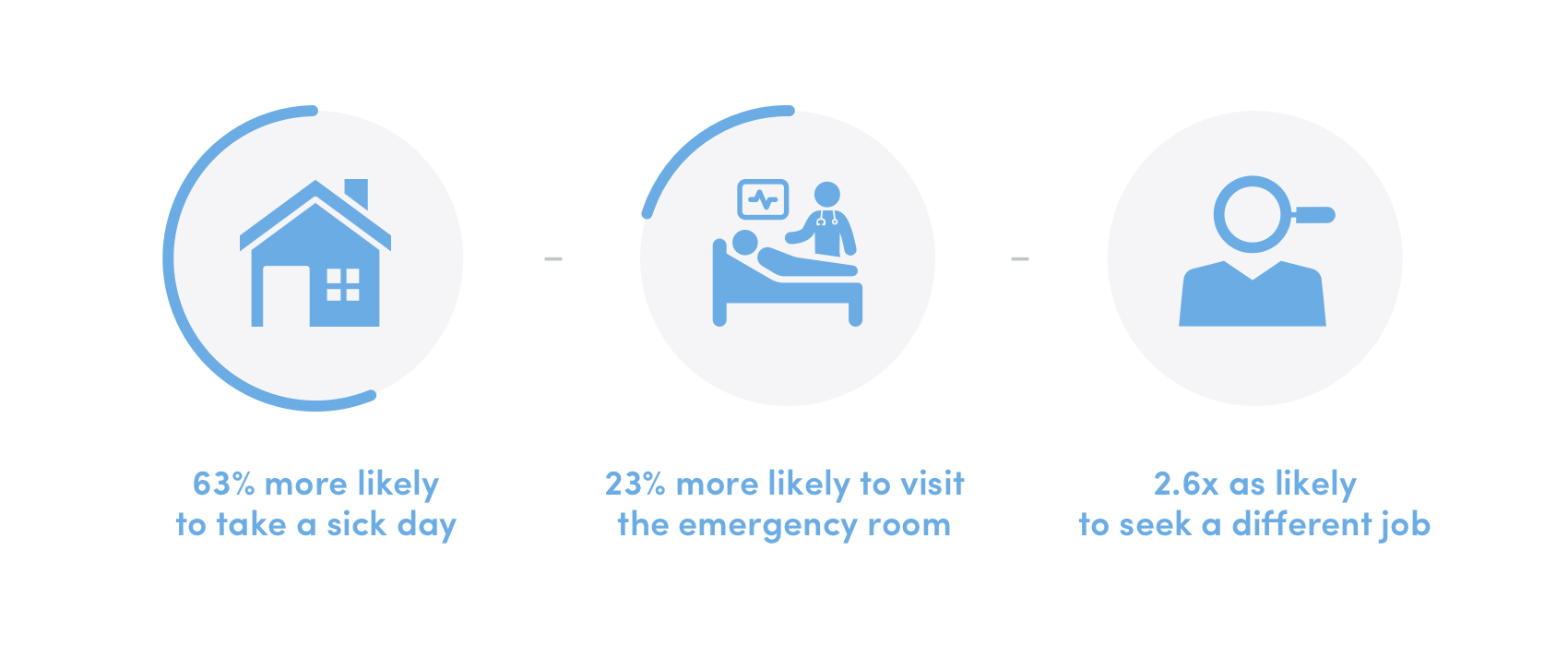According to a recent study by Gallup, 28% of employees surveyed said they were burned out “very often” or “always” at work. Employee burnout and fatigue is detrimental to both the employee and the business. This same study found that employees who frequently experience burnout are:
- 63% more likely to take a sick day
- 23% more likely to visit the emergency room
- 2.6x as likely to seek a different job
Within an organization, the role of the manager is critical in assessing and addressing employee burnout. Workload balance naturally varies over time throughout the ebb and flow of projects, business cycles, and changes in team staffing levels. But, when heavy workloads are sustained over a significant period of time, or other factors impact an employee’s feelings of engagement and satisfaction with their work, burnout can quickly develop and take a toll if not addressed by the manager.
Addressing these issues are paramount to employee happiness and overall organizational well-being.
In this article we’ll cover:
- Guiding principles to help you get and stay ahead of burnout.
- How to identify signs of employee burnout as a manager and how to mitigate them
What Is Employee Burnout?
Employee burnout is a form of work-related stress where employees feel physical, mental and emotional exhaustion caused by their work. Employees experiencing burnout may feel anxious and overwhelmed, which results in them feeling like they aren’t accomplishing anything or that their work doesn’t matter. This leads to a drop in engagement and productivity, as employees lose interest in their work or job in general.
When employee burnout spreads throughout a team or organization, it hurts the workplace culture and can lead to performance issues or higher turnover.
Guiding Principles to Get Ahead of Burnout
Ideally, organizations are able to employ practices and policies that allow managers to identify burnout risks and adjust operating procedures to ensure work gets done without burnout out your team.
Here are a few guiding principles that will help you identify burnout early and avoid the issue before it starts:
- Invest time and attention in your team members
- The best managers hold regular (at least bi-weekly) 1×1’s with each team member. They know each person as an individual, celebrate accomplishments, touch base on project deliverables, conduct coaching conversations and discuss possible sources of frustration.
- Promote transparency and problem-solving
- Host a monthly team check-in to allow for broader team discussions on what is going well and what can be improved. This meeting can help surface sources of friction, resource gaps, and process improvements that can help boost team productivity and satisfaction. Check out our blog post “How to hold a Ways of Working discussion with your team” for tips on gaining team alignment.
- Advocate for the resources your team needs
- Combine team sentiments with workforce analytics data to help justify and plan for headcount:
- Has the workload for your team scaled at a faster pace than headcount?
- How does the workload for your team compare to other similar teams?
- Is your team often working on the weekend or evenings?
- Using a workforce analytics solution like ActivTrak, you can measure productive time, working hours, burnout risk, break frequency and focus habits to justify additional resources, or shift expectations to help support teams who are facing burnout.
- Combine team sentiments with workforce analytics data to help justify and plan for headcount:
6 Common types of Burnout & How Managers can help

Burnout comes in many different forms across organizations. Understanding the culprit behind the burnout can help you coach your team or individual team members through the challenge.
The most common types of Burnout include:
Deadline Burnout:
Deadline burnout occurs when specific deadlines are aggressive and compounded by obstacles, therefore the ability to get work done on time is a challenge. The stressors of “figuring it out” on time, while preserving quality, have an impact on employees. Whether it’s working additional hours or working the same hours at a higher intensity, deadline burnout can be particularly draining
Common causes:
- Disconnect between project management and team members
- Improper scoping
- Unrealistic timelines
- Unforeseen project risks, dependencies, and challenges
- Inadequate stakeholder management and expectation setting
Deadline burnout signs to look for:
- Team members working longer days, and outside of their normal working hours
- Hastened or canceled meetings to free up additional working time
- “Shortcuts” on processes or quality to complete activities faster
- Errors in work or a decline in work quality/thoroughness
- Missed deadlines
How managers can help:
- Reach out to the impacted individual(s) to check in, not just about project deadlines, but how they are feeling about their work.
- Ask questions around what resources may be needed to:
- Alleviate the burnout
- Help get the project/work done well and at a reasonable time
- Remove obstacles/friction that could be causing frustration
- Commit to providing support and working towards a solution within a clear period of time
- Before problem-solving:
- Acknowledge that they may be feeling stressed
- Show gratitude for this work and empathy for the pressure created by tight deadlines
- Express your desire to explore ways to relieve the pressure, if possible/acceptable to stakeholders
Culture Burnout:
Culture burnout happens when a group within an organization has collectively reached levels of exhaustion that are uncomfortable and is further perpetuated by the shared exhaustion of others. The exhaustion does not always stem from long hours, but can also come from team-wide dynamics that are depleting employees’ energy, engagement, and commitment levels.
Common Causes:
- Disconnect between leadership mission, vision, strategy, goals, and employees beliefs
- Inconsistency in strategic direction and approach to work
- Distrust/lack of transparency
- Unclear communication from leadership to employees
- Tension within the organization and among peers
- Stress around company or team performance
- External current events that have a substantial impact on morale and anxiety levels
Culture burnout signs to look for:
- Decrease in work hours or variation from typical work schedule
- Negative or unusually little feedback from typically vocal/engaged employees
- “Shortcuts” on processes or quality due to lack of commitment/ understanding of purpose
- Errors in work or a decline in work quality/thoroughness
- Missed deadlines
How Managers can help:
Culture burnout within a team can quickly spread to surrounding teams and become pervasive throughout the organization. For this reason, recognizing it quickly and devising a strategy to solve it is essential.
- Try to sort out the primary causes referring to the list above and remember that causes are often interrelated, so more than one is likely to exist.
- Depending on the primary causes:
- Work among leadership on what actions can be taken to communicate with the impacted group
- Collect feedback and share understanding
- Commit to improving the implications
- Actions taken must be consistent over a period of time to regain trust and alleviate the culture burnout felt by employees. The risk of engaging with the impacted group once and not remaining consistent and committed to your promises can cause even greater cultural burnout over time.
Personal Burnout:
Personal burnout is different from culture burnout in that it impacts a single individual within the workplace. While the impact is more limited, it’s important to highlight that a series of individuals experiencing personal burnout can often aggregate into a culture burnout dynamic. It is important to address personal burnout so that it does not trickle into team dynamics and lead to greater risk across a group.
Common causes:
- Unclear expectations between manager and employee
- Inconsistent communication and guidance
- Unclear career pathing, performance feedback, or job growth for employee
- Role misalignment and fatigue
- External extenuating circumstances that put pressure on ability to focus and perform in the workplace
- External current events that have a substantial impact on morale and anxiety levels
Personal burnout signs to look for:
- Expressed challenges and difficulties during 1×1 meetings or with other team members
- Deviations from typical work quality (including errors and missed deadlines)
- Decrease in work hours and variation from typical schedule
- Negative or unusually little feedback from typically vocal/engaged employees
- Hastened or canceled meetings to free up additional working time on the calendar
How managers can help:
- Reach out and set up 1×1 time and let your employee know in advance that you aim to discuss how they are doing personally and professionally
- Before problem solving:
- Inquire about what resources the employee may need to feel supported in their work. This could include:
- Reshifting of workload
- Modification of deadlines to alleviate pressure
- Support with at-home workplace resources
- Commit to providing support and working towards a solution within a very clear period of time. If you’re unable to offer immediate solutions in the conversation (which is common), let your employee know when you both can expect to revisit the conversation.
Passion Burnout:
Passion burnout is most typically identified at the individual level within the organization. Passion burnout can occur when someone’s focus (sometimes by their own choice) on a particular work topic, skillset or set of work activities becomes overwhelming due to the degree of perceived completeness and perfection required, the lack of work variety, or feelings of isolation.
Common causes:
- Focus on a single topic for a prolonged period of time; lack of workload diversity
- Lack of short term, achievable goals to help showcase progress towards overarching goals
- Limited exposure to other parts of the organization and thus, diminished line of sight into bigger picture
- Self-criticism as a result of misalignment in the degree of thoroughness/perfection required
- Being overwhelmed by details; despite caring deeply, the individual may struggle with where to begin
Passion burnout signs to look for
- Working outside of typical work schedule
- Hastened or canceled meetings to free up additional working time on the calendar
- Hyperfocus on a task or topic of interest at the expense of critical business needs or other responsibilities
- Delivering work far beyond the necessary scope
- Excessive time devoted to analysis versus decision-making to achieve business outcome
- Disengagement in the topic after extended period of time of high engagement
How managers can help:
Passion is something that we aim to foster in our organizations so addressing passion burnout requires a high level of sensitivity on the part of the manager. The key to maintaining the passion while reducing burnout is to provide a clear scope of work, time-bound milestones and desired set of objectives. Achievement and progress is a key way to alleviate the pressure of burnout. Without direction and distant or ambiguous deadlines, employees can get so deeply immersed in their specialty areas that they burnout before reaching the goal.
Skill Burnout:
Skill burnout is a result of individuals facing skill deficiencies or excesses in their specific roles. Ultimately, this type of burnout leads to employees feeling frustrated and misplaced in their roles. Providing team members with the skills required for their role is key for establishing strong alignment. When employees have skills that exceed their role, it becomes important to diversify the workload, introduce stretch projects, or provide role mobility so that they can grow.
Common Causes:
- Limited and/or inadequate training opportunities
- Limited career mobility leaving employees in roles for too long
- Limited project and work diversity
- Insufficient career-pathing to provide role growth opportunity and skill development
- Lack of performance management process Inadequate communication between managers and employees around necessary and desired skills
Skill burnout signs to look for:
- Working outside of typical work schedule
- Displays of boredom (low meeting participation, high distractions, etc.)
- Disengagement from work
- Time spent on work unrelated to role
- Requests for additional training and development
How managers can help:
Skill deficiencies can be uncomfortable and trigger insecurities for employees and must be handled delicately.
- Explore with your direct reports what skill gaps may exist for their particular work or where they may feel overqualified and seek greater challenges.
- An open discussion around skill burnout is the first step which should be swiftly followed with:
- A commitment to additional learning opportunities
- Career mobility for those ready and qualified for additional experiences
- Additional training and support for those who need further development
Alignment Burnout:
Alignment Burnout stems from dissonance between what something is intended to be and what something is. This can occur across the entire organization as it pertains to the mission, within a team as it concerns its strategy, or at the individual level as it relates to a role description. The disconnect between what should be and what is can create ambiguity, anxiety, and frustration that over time, leads to burnout.
Common Causes:
- Limited, unclear or inconsistent goal-setting
- Lack of communication between leadership, teams, and individuals
- Absence of job descriptions and career paths across the organization
- Lack of established performance management process with opportunities for two-way feedback
Alignment burnout signs to look for:
- Working outside of typical work schedule
- Disengagement from work
- Time spent on work unrelated to role or team priorities
- Missed deadlines or lower quality of work
- Duplicative and/or redundant work across roles
How managers can help:
While misalignment can lead to frustration, it also presents an opportunity to improve communication and clarify objectives. However, it is also important to recognize that alignment may not always equate to making all parties happy. There are many different ways to solve a problem, each with its own tradeoffs. The goal for establishing alignment is not to ensure all employees agree or are happy, it’s to ensure that everyone is working together with clear objectives and expectations.
Addressing Team Misalignment
- Bring the group together to acknowledge the burnout sentiment and provide space for shared concerns
- Understand where and why the confusion may exist:
- If perceived objectives and goals vary due to miscommunication, clarify the strategy
- If perceived objectives and goals vary due to disagreement on approach, discuss
Addressing Organizational Misalignment
- Understand from your own team where they see misalignment across teams
- Connect with other team managers to establish understanding and alignment in work approach
- Host one or multiple meetings to understand what different teams expect from one another
- Once expectations are set with other team leaders, return to your team to communicate expectations and established alignment
While six burnout types are outlined in this guide, the categories, employee burnout symptoms and causes are not mutually exclusive. The prevalence of one burnout type can lead to other types of burnout, which is how it can compound and become harder to address and contain. This is why it is so critical for managers to have the right tools and knowledge to watch out for signs of employee burnout, and address them as proactively as possible.






